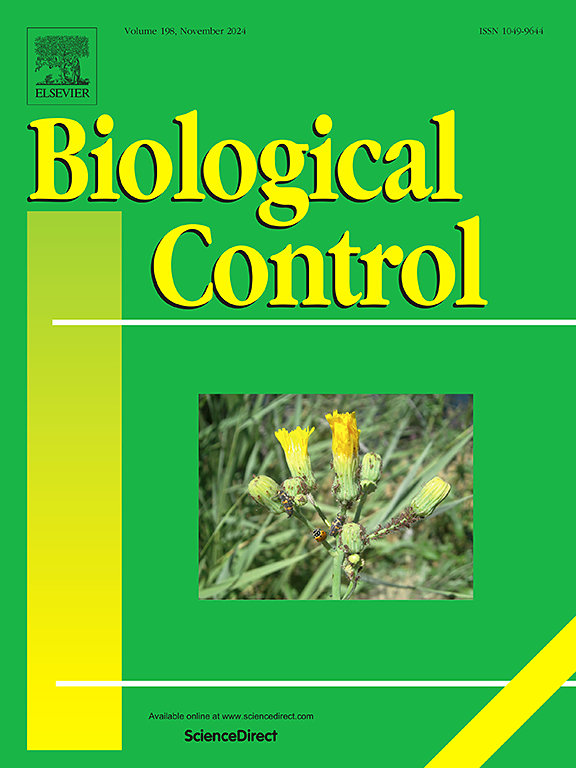Mycin and peptin lipopeptides are major contributors to the biocontrol of Sclerotinia sclerotiorum by Pseudomonas mediterranea
IF 3.4
2区 农林科学
Q2 BIOTECHNOLOGY & APPLIED MICROBIOLOGY
引用次数: 0
Abstract
The fungal pathogen Sclerotinia sclerotiorum is the causal agent of the white mold disease in several economically important crops. Control methods are currently limited to the use of synthetic fungicides and resistance to these fungicides is increasing. Biological control may prove to be a more sustainable control strategy for this disease, as well as other fungal diseases. In a previous study, our team identified Pseudomonas strains that can reduce white mold symptom severity in lettuce. The exact mechanisms underlying this biocontrol were not explored, but the biocontrol activity of these Pseudomonas strains strongly correlated with the presence of three gene clusters involved in the biosynthesis of the lipopeptides brabantamides, corpeptin, and thanamycin. In this study, to better understand the mechanisms at play and progress towards the development of a Pseudomonas-based biocontrol inoculant against S. sclerotiorum, key genes involved in the biosynthesis of these lipopeptides were knocked out in the genome of P. mediterranea B21-060. The impact that the loss of function had on the ability of P. mediterranea to inhibit the growth or S. sclerotiorum in vitro and control white mold development in planta was evaluated. Production of corpeptin and thanamycin by P. mediterranea was required to repress the growth of S. sclerotiorum and suppress white mold symptom development in lettuce. Furthermore, corpeptin and thanamycin were also identified as key inhibitory molecules against Botrytis cinerea and Rhizoctonia solani, two other important fungal pathogens. This study highlights the potential of corpeptin and thanamycin in Pseudomonas-mediated control of different fungal plant diseases.
霉菌素和肽脂肽是地中海假单胞菌防治菌核病的主要物质
菌核菌是几种重要经济作物发生白霉病的病原。目前的控制方法仅限于使用合成杀菌剂,对这些杀菌剂的耐药性正在增加。生物控制可能被证明是一种更可持续的控制策略,对这种疾病,以及其他真菌疾病。在之前的一项研究中,我们的团队发现了假单胞菌菌株,可以减轻生菜的白霉症状严重程度。这种生物防治的确切机制尚不清楚,但这些假单胞菌菌株的生物防治活性与三种基因簇的存在密切相关,这些基因簇参与脂肽布拉班胺、corpeptin和thanamycin的生物合成。在这项研究中,为了更好地了解其作用机制和开发一种以假单胞菌为基础的抗菌核葡萄球菌生物防治接种剂的进展,在地中海葡萄球菌B21-060基因组中敲除了参与这些脂肽生物合成的关键基因。研究了功能丧失对地中海葡萄球菌体外抑制菌核菌生长和控制植物白霉发育的影响。地中海单胞菌需要产生corpeptin和thanamycin来抑制菌核单胞菌的生长和抑制生菜白霉病的发展。此外,corpeptin和thanamycin也被鉴定为对灰葡萄孢菌(Botrytis cinerea)和solani Rhizoctonia这两种重要真菌病原体的关键抑制分子。这项研究强调了corpeptin和thanamycin在假单胞菌介导的不同真菌植物病害控制中的潜力。
本文章由计算机程序翻译,如有差异,请以英文原文为准。
求助全文
约1分钟内获得全文
求助全文
来源期刊

Biological Control
生物-昆虫学
CiteScore
7.40
自引率
7.10%
发文量
220
审稿时长
63 days
期刊介绍:
Biological control is an environmentally sound and effective means of reducing or mitigating pests and pest effects through the use of natural enemies. The aim of Biological Control is to promote this science and technology through publication of original research articles and reviews of research and theory. The journal devotes a section to reports on biotechnologies dealing with the elucidation and use of genes or gene products for the enhancement of biological control agents.
The journal encompasses biological control of viral, microbial, nematode, insect, mite, weed, and vertebrate pests in agriculture, aquatic, forest, natural resource, stored product, and urban environments. Biological control of arthropod pests of human and domestic animals is also included. Ecological, molecular, and biotechnological approaches to the understanding of biological control are welcome.
 求助内容:
求助内容: 应助结果提醒方式:
应助结果提醒方式:


